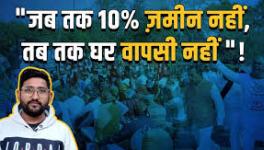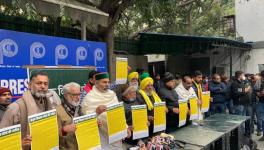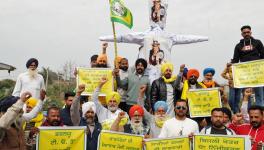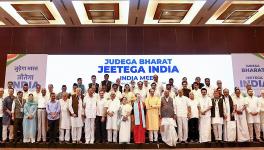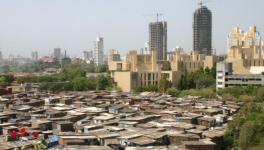Republic Day: Farmers’ Storm Capital, Big Protests Across Country
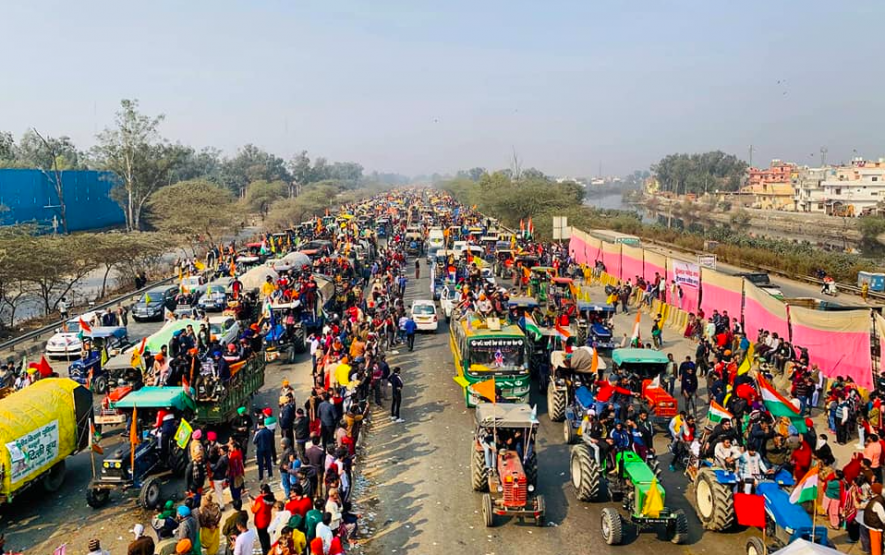
Dramatic events in the country’s capital on Republic Day appear to have overshadowed the much bigger message that farmers’ protests sent to the people of the country as also to the Central government led by Prime Minister Narendra Modi. This is largely because the ‘godi’ (lapdog) media has reflexively turned on its outrage spigot at the so-called ‘desecration’ of Red Fort, and the fact that thousands of farmers veered off from the pre-agreed routes for ‘Tractor Parades’, and drove into the heart of the metropolis, breaking up barriers put up to prevent just that eventuality.
Undoubtedly, the wayward farmers’ contingents should have stuck to the agreed routes like their thousands of other fellow participants did. And, undoubtedly, there was no need to barge into Red Fort or unfurl flags there.
But, if you take a step back and think about it, the so-called “violence” that the media and official machinery is railing against was what? That they broke cement and metal barriers? That they overturned containers and shifted dumpers? Again, not desirable, nor agreed upon, but that was all the violence. Some buses parked as barriers were also damaged. Police personnel were injured in clashes. But so were protesters. In fact, one of them died at ITO crossing, allegedly because his tractor overturned as he and some others drove their vehicles round and round to clear the crossing of policemen.
The Samyukta Kisan Morcha (an umbrella body of all farmers organisations involved in the Delhi protests) has criticised the violence and dissociated itself from the groups that split away from the main ‘Tractor Parades’. They said there were some organisations of farmers that did not agree with the pre-arranged route and wanted to head straight into the centre of the city.
It should also be noted that the present situation has arisen because of the Modi government’s rigid approach to the farm laws, refusing to yield on what was clearly a very unpopular set of laws. It is the Modi government that rammed these black laws down the country’s throat, first as ordinances and then through an undebated, unvoted procedure in Parliament, using its brute majority.
The Modi government has refused to understand the anger and resentment that has built up as farmers’ organisations patiently went through 11 rounds of talks, half of which were used by the government to make presentations about how good these laws were. The ruling party, the Bharatiya Janata Party, has no courage to tell its Prime Minister that there is deep anger on the ground. The bureaucrats are even more cowardly. And the Prime Minister, unfortunately, thinks that this is what is best for the country because it is recommended by neoliberal economists tied to Western countries.
But what the narrative being put out by the mainstream media omits to mention is also remarkable.
Unprecedented Sweep of Protests
At the call of the All India Kisan Sangharsh Coordination Committee (an umbrella front of over 500 farmers’ organisations from all states) tractor parades, protest demonstrations, dharnas, etc. were held in all states of the country. These were not small affairs – in Kerala, Tamil Nadu, Andhra Pradesh, Telangana, all districts saw such protests.
In Maharashtra, these district protests had already taken place in the run-up to the Republic Day and over 15,000 farmers had marched to Mumbai and held a rally in the heart of the city on January 25. In Madhya Pradesh, Karnataka, Uttar Pradesh, tractor parades and other protests were held in several districts.
Farmers from Western and central Uttar Pradesh, Uttarakhand, Punjab, Haryana had already converged at the Capital’s borders for the Republic Day protest. They had been joined by big and small contingents from all states, including Odisha, Chhattisgarh, Madhya Pradesh, Rajasthan, West Bengal and others. In West Bengal, a 72-hour Mahapadav had already been observed and tractor parades were held at various districts, including Burdwan, 24-Parganas and others. Even in distant Assam protests were held. In Gujarat, too, small protests could be held although the BJP-led state government cracked down on farmers’ protests from November itself.
What does this show? Undoubtedly, the sweep of anger against the three farm laws is unprecedented if these protests are anything to go by. No part of the country is untouched. Since the mainstream media ignores all this, and the government chooses to ignore it, both cannot understand the depth of anger that exists in the country against these laws. Hence, there is rather childish speculation by some people that the Delhi events on January 26, will puncture the movement.
Scale of Participation Growing
The support for farmers is growing with each passing day as the Modi government continues to stick to its rigid position of not repealing the laws. This was clearly seen in the Capital today. The number of farmers and their beloved tractors that lined up the highways was beyond all expectations. Both the Samyukt Kisan Morcha (SKM)leadership and the police/Home Ministry were taken aback at the sea of tractors that surrounded Delhi with lines stretching dozens of kilometres into the hinterland. This despite the fact that the BJP government in UP tried its best to stop the farmers by refusing diesel for their tractors, checking their registration numbers and recording their movement in an attempt to sow fear of later harassment. But virtually every village in Haryana and Punjab, and wide swathes in Western UP took to the roads, packed up their tractors with food and provisions, and headed out.
The energy and enthusiasm of farmers were brimming over. It was not surprising that the routes that the SKM had agreed to for the ‘Tractor Parades’ around the Capital, with just short distances actually inside the borders, were not able to accommodate the surge of participants.
Not anticipating this was a failure of the government, too. They were too obsessed with the question of not allowing anybody to enter far enough. So, the breaking of barriers by an impatient surge of farmers was waiting to happen. In fact, the police had mildly anticipated this – that’s why they had barricades deep inside Delhi. But nobody had expected this scale of participation.
The same has happened elsewhere. As NewsClick’s reports from across several states show, unprecedented numbers of farmers participated in the protests in various states and unexpected protests materialised in several other locations.
Another notable feature is that farmers are getting support from all other sections of people. In all states, and in Delhi too, farmers were welcomed at dozens of points by students, women, middle class employees, workers, and other people. In Delhi, people turned out in large numbers to just watch the parades.
Modi Govt Needs to Read the Message
The protests of January 26, 2021 have sent a strong and unambiguous message to the Modi government – unless you listen to the farmers’ voice, the protests will only escalate. The myths about this being an agitation by farmers from a few states or it being backed by vested interests were all blown to smithereens today.
Tuesday was a never-seen-before moment and the government failed to understand its depth and sweep, wedded as they are to the discarded and discredited ideology of free market and corporate-led economic growth. It is time for them to understand and repeal the laws -- lock stock and barrel – otherwise the country will be plunged into ever widening protests.
Get the latest reports & analysis with people's perspective on Protests, movements & deep analytical videos, discussions of the current affairs in your Telegram app. Subscribe to NewsClick's Telegram channel & get Real-Time updates on stories, as they get published on our website.










